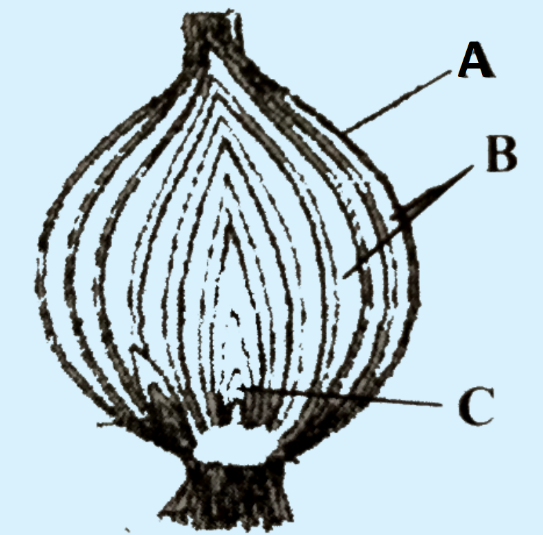Question
Question: The given figure represents the V.S of bulb of _Allium cepa_. Identify the different parts and selec...
The given figure represents the V.S of bulb of Allium cepa. Identify the different parts and select the correct option.

A: Fleshy scales B: Tunic C: Terminal bud
A: Tunic B: Terminal bud C: Fleshy scales
A: Tunic B: Fleshy scales C: Terminal bud
A: Terminal bud B: Fleshy scales C: Tunic
Solution
Allium cepa is the scientific name of onion. Onion belongs to the family Liliaceae. The stem of the onion is bulb type & it has edible fleshy scales/leaves. When photosynthesis occurs in onion leaves with chloroplast, the glucose produced during the process is converted to starch and stored in the bulb. In the outer portion, the fleshy scales represent leaf bases, while in the middle, they represent scale leaves. They happen in a circular pattern. A whitish or pinkish tunic covers the bulb. The terminal bud is encased in fleshy scales.
Complete answer:
According to the given explanation in the hint section, this option does not give the proper labelling of the diagram. A is the outer pinkish covering tunic and B represents the scales.
So, option (a) is incorrect.
We now know that the fleshy scales enclose the terminal bud in onions and therefore B can not be terminal bud and C cannot be the scales, as given is this option.
Hence, option (b) is incorrect.
Tunic is the outer covering as represented by A in the given diagram and B, C also shows the correct labelling of the parts as fleshy scales and terminal bud respectively.
Option (c) is correct.
A is outer covering and does not represent the terminal bud. Also, C is the terminal bud, the primary growing part which is present at the shoot apex.
So, option (d) is incorrect.
Hence, the correct answer is option (c).
Additional Information:
Other characters of family Liliaceae:
These are monocots and have fibrous roots.
Their leaves have parallel venation and are exstipulated.
Shows cyamose (umbel) inflorescence.
The flower is bisexual and hypogynous.
These are tetramerous and have tepals (perianth), with valvate aestivation.
Androecium is polyandrous and epiphyllous.
Gynoecium is syncarpous and tricarpellary.
Note:
Different parts of plants show different modifications in different plants. Onions are an example of a modified underground stem, in which the stem is reduced and is present in the form of a disc, called a “bulb”. The fleshy leaves of a bulb functions as food reservoirs that enable a plant to lie dormant when water is unavailable and resume the growth when favorable conditions return.

